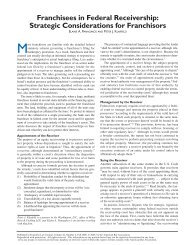Los Angeles Lawyer October 2008 - Gray Plant Mooty
Los Angeles Lawyer October 2008 - Gray Plant Mooty
Los Angeles Lawyer October 2008 - Gray Plant Mooty
Create successful ePaper yourself
Turn your PDF publications into a flip-book with our unique Google optimized e-Paper software.
ecords. All have policies and practices for<br />
addressing gender reclassification in their systems.<br />
In the last 40 years, many of these<br />
agencies and institutions formulated written<br />
policies that include medical evidence requirements.<br />
Interestingly, these policies are wildly<br />
inconsistent in their requirements, not only<br />
between the states but even between different<br />
agencies within the same state, city, or county.<br />
For example, California’s gender change<br />
policy for birth certificates requires the applicant<br />
to show that he or she has undergone any<br />
of a variety of gender confirmation surgeries,<br />
22 which could include chest surgery<br />
(breast enhancement for trans women or<br />
mastectomy and reconstruction for trans<br />
men), tracheal shave (“Adam’s Apple” reduction),<br />
penectomy (removal of the penis),<br />
orchiectomy (removal of the testicles), vaginoplasty<br />
(creation of a vagina), phalloplasty<br />
(creation of a penis), hysterectomy (removal<br />
of internal pelvic organs), or any one of a<br />
range of other gender-related surgeries. When<br />
addressing birth certificate gender reclassification,<br />
New York City and New York State<br />
each require genital surgery. However, their<br />
genital surgery requirements differ entirely.<br />
People born in New York City are required<br />
to provide evidence that they have undergone<br />
phalloplasty or vaginoplasty, while people<br />
born in New York State must provide<br />
evidence that they have undergone penectomy<br />
or hysterectomy and mastectomy. 23<br />
The fact that two jurisdictions issuing birth<br />
certificates in the same state have come up<br />
with entirely different requirements for recognition<br />
of gender change alone attests to the<br />
inconsistency in this area.<br />
Gender reclassification policies also often<br />
tie recognition to the ability to show that<br />
other identity documents have already been<br />
changed. Massachusetts, for example, will<br />
only change DMV ID when an applicant<br />
shows both proof of surgery (unspecified)<br />
and a birth certificate indicating the new gender.<br />
For people born in Tennessee, which<br />
does not change birth records, and living in<br />
Massachusetts, this would be an impossibility.<br />
24 Further, gender reclassification policies<br />
often include requirements of recognition by<br />
other agencies or institutions.<br />
The SSA’s policy requires genital surgery<br />
but is nonspecific regarding which surgeries<br />
will be accepted. 25 Some DMV gender reclassification<br />
policies—such as those of Colorado,<br />
New York, and the District of Columbia—do<br />
not require evidence of surgery but still require<br />
medical documentation in the form of a doctor’s<br />
letter attesting that the person is transgender<br />
and is living in the new gender. 26<br />
The results of these varying medical evidentiary<br />
requirements by ID-issuing organizations<br />
are several. Many transgender people,<br />
depending on which state they live in and<br />
which state they were born in, cannot get<br />
any ID that matches their current gender or<br />
can only get some pieces of ID that match current<br />
gender, meaning that when an employer<br />
or someone else needs to see multiple pieces<br />
of ID they will be outed as having a prior gender<br />
marker. Not being able to obtain corrected<br />
ID can lead to unemployment, difficulty<br />
in interactions with the police (including<br />
discrimination and violence), 27 problems<br />
entering age-barred venues or purchasing<br />
age-barred products, accusations of fraud in<br />
a variety of situations, traveling difficulties,<br />
and other complications.<br />
Additionally, recent law and policy<br />
changes at the federal level have focused on<br />
making increasing comparisons between databanks<br />
of different ID-issuing agencies such as<br />
the SSA and the various DMVs, or using SSA<br />
records to confirm employment eligibility.<br />
These policies seek to find people with mismatching<br />
information on various types of<br />
records. Many transgender people have gotten<br />
caught up in these “no match” problems<br />
due to having mismatching gender markers on<br />
different IDs due to ID-issuing agencies having<br />
different rules regarding gender marker<br />
correction. 28<br />
The belief that the recognition of trans<br />
people’s gender identities requires medical<br />
verification is also reflected in case law. Cases<br />
in which courts have recognized a transgender<br />
person’s heterosexual marriage frequently<br />
focus on the person’s successful completion<br />
of various surgical interventions. 29 Cases in<br />
which courts have affirmed that transgender<br />
people are covered by antidiscrimination laws<br />
often rely on a medical component for trans<br />
identity, 30 although cases in which courts<br />
have found transgender people outside the<br />
ambit of antidiscrimination laws have also, at<br />
times, relied on a medical framework. 31<br />
In general, the association between transgender<br />
identity and medical care, especially<br />
surgery, is so common that judges frequently<br />
use it as the primary paradigm for thinking<br />
about trans people’s identities regardless of<br />
whether they decide in favor of a transgender<br />
litigant or not. The codification of this myth<br />
into law means that even the well-intentioned<br />
work that some lawmakers, judges, and advocates<br />
do to increase transgender recognition<br />
and overcome Myth #1 has no beneficial<br />
impact on the majority of trans people who<br />
do not or cannot have surgery, or not the particular<br />
surgery a given rule is based upon, as<br />
part of their gender expression.<br />
Myth #3: Trans people’s genderconfirming<br />
healthcare is not legitimate<br />
medicine.<br />
The third myth that causes major obstacles in<br />
law and policy for transgender people claims<br />
that gender-confirming healthcare for transgender<br />
people is not legitimate medicine. This<br />
myth can be seen in the policies and practices<br />
of a variety of private and public entities that<br />
provide or insure healthcare. 32 State Medicaid<br />
programs and private insurers often have<br />
explicit exclusions of this care in their policies.<br />
If they do not, they reject individual<br />
claims on a case-by-case basis. 33 Additionally,<br />
state and federal programs that are responsible<br />
for providing healthcare for people in<br />
their custody, such as foster care programs,<br />
juvenile justice programs, 34 and prisons, 35<br />
frequently deny gender-confirming care either<br />
in a written policy or in an unwritten blanket<br />
practice.<br />
The denial of gender-confirming healthcare,<br />
along with the incorrect assumption<br />
that most transgender people undergo surgery,<br />
results in several negative consequences. First,<br />
the inability to receive this care has severe<br />
health consequences for those who need it.<br />
Depression, anxiety, and suicide are commonly<br />
linked to the unmet need for genderconfirming<br />
medical care. 36 According to the<br />
few studies that have been done on the issue,<br />
HIV rates are also extremely high among<br />
transgender people. 37 One study found seroprevalence<br />
in 63 percent of African American<br />
trans women. 38 A contributing factor to this<br />
may be that many people seek treatments on<br />
the black market and receive care without<br />
medical supervision because it is not available<br />
through more legitimate means. This avenue<br />
to care may result in inappropriate dosage,<br />
nerve damage, and HIV and hepatitis infection<br />
resulting from injections without medical<br />
supervision or clean needles. 39<br />
Additionally, research has shown that the<br />
inability to receive appropriate healthcare<br />
may be a contributing factor to the high rates<br />
of incarceration of transgender youth and<br />
adults. 40 Indeed, overrepresentation in the<br />
juvenile and adult criminal justice systems is<br />
an ongoing issue for the transgender population.<br />
Factors contributing to this overrepresentation<br />
include participation in black<br />
market transgender healthcare and, more<br />
broadly, participation in criminalized activity<br />
such as sex work to survive. 41 This occurs<br />
for several reasons. Most centrally, many<br />
transgender people turn to informal or illegal<br />
economies to get by due to high levels of<br />
unemployment, homelessness, and poverty<br />
stemming from discrimination and economic<br />
marginalization. Transgender imprisonment<br />
may also be elevated because of a widespread<br />
trend of police profiling that has been documented<br />
in the United States. 42<br />
Finally, transgender imprisonment is also<br />
bolstered by lack of access to alternatives to<br />
incarceration. For example, many nonprofit<br />
drug treatment programs refuse transgender<br />
applicants, sometimes based on an assertion<br />
that they lack the experience or expertise to<br />
38 <strong>Los</strong> <strong>Angeles</strong> <strong>Lawyer</strong> <strong>October</strong> <strong>2008</strong>







